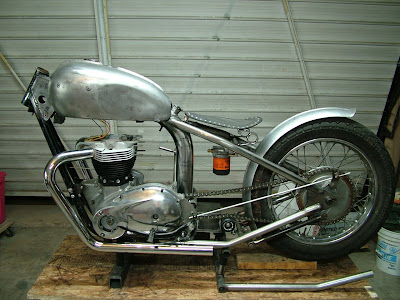This project started when our current client saw this fabrication shot, and asked if we could do a bare metal tank and fender. Not being a fan of clear coat over steel (since it looks like clear coat over steel, and I have heard that it is possible for water to condense between the clear coat and steel), I went looking for an alternate solution. The client lives in Louisiana, and is in the military, so giving the tank a monthly coat of polish wasn't going to cut it, between humidity and deployment, it would have never looked good, particularly since the fender is aluminum, and they would never looked right together on the bike.
 |
| Half done, kinda. |
Enter the solution. I helped a buddy of mine build his Triumph while he was in San Diego, and long story short, the answer is having molten metal sprayed onto a gas tank. This one was done in aluminum, but I think a brass tank and fender would be really cool too.
The piece coming back from the sprayer has a texture similar to sprayed ceiling, which is a bit of pain to finish. I knocked it down a bit with an orbital sander, then spent an ungodly amount of time hand sanding.
 |
| mm... popcorn. |








